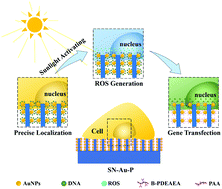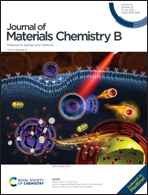Promoting gene transfection by ROS responsive silicon nanowire arrays†
Abstract
The development of a fast and safe reactive oxygen species (ROS)-responsive vector is generally limited by the intracellular unstable ROS concentration, and a relatively long time is still needed for the complete intracellular release of drugs or genes induced by ROS. In this work, a gene transfection platform based on ROS-responsive silicon nanowire arrays (SN) is developed, to promote the gene transfection efficiency for several cell lines. Briefly, the surface of the ROS generating system, gold nanoparticle modified SN (SN–Au), is grafted with poly[(2-acryloyl)ethyl(p-boronic acid benzyl)diethylammonium bromide] (B-PDEAEA), an oxidation-responsive charge-reversal cationic polymer. Plasmid DNA (pDNA) bound on the surface through electrostatic interactions was directly delivered into the cells by the time the nanowires penetrate the cells. SN–Au can generate ROS under light treatment, which has an influence on the surface charge change of B-PDEAEA grafted on gold nanoparticles, realizing effective pDNA release in the cytosol for transfection. Nearly 80% of DNA released from the surface of the platform after treated with 1 mM ROS for 10 min. The transfection efficiency of the platform for several cell types was significantly enhanced after a short period of light exposure (3.2-fold for HeLa cells, 7.6-fold for L929 cells, 2.3-fold for BMSC cells and 6.2-fold for mESC cells). The platform also has good biocompatibility. Overall, our results suggest that ROS-responsive SN is a novel, efficient and safe platform for drug and gene transfection.



 Please wait while we load your content...
Please wait while we load your content...